Contrasts in Two-Stage Superimposed Magmatism of the Shizhuzi Magmatic Complex-Mo-Cu-Au System, Liaodong Peninsula, North China Craton
Abstract
1. Introduction
2. Geological Background
2.1. Regional Geological Setting
2.2. The Shizhuzi Magmatic Complex-Mo-Cu-Au System
3. Sample Descriptions and Analytical Methods
3.1. Zircon U-Pb Dating
3.2. Whole-Rock Element Analyses
3.3. In Situ Zircon Hf Isotope Analyses
4. Results
4.1. Petrography for the SMC Granitoids
4.2. Zircon U-Pb Ages
4.3. Whole-Rock Geochemistry
4.4. In Situ Zircon Hf Isotopes
5. Discussion
5.1. Two Stages of Magmatism and a Stage of Mineralization
5.2. Petrogenesis of the Mineralized Granitoids
5.3. Petrogenesis of the Non-Mineralized Granitoids
5.4. Comparison of the Mineralized and Non-Mineralized Granitoids
5.5. Magmatic Evolution Model
6. Conclusions
- (1)
- The Shizhuzi magmatic complex records two distinct magmatic stages: an early mineralizing stage (130–126 Ma) forming Mo-Cu-Au deposits; and a late magmatic stage (121–117 Ma), representing a typical product of the peak destruction period of the North China Craton.
- (2)
- The mineralized granitoids exhibit I-type affinities and formed in an extension setting. The quartz diorite was derived from the partial melting of an enriched mantle source, whose subsequent high-temperature thermal underplating triggered partial melting of basaltic lower crust to generate the granodiorite and monzonitic granites. These rocks underwent limited fractional crystallization (plagioclase + biotite) and are associated with Mo-Cu-Au mineralization.
- (3)
- The non-mineralized granitoids are high-K calc-alkaline, peraluminous A2-type granites formed in an extremely extensional tectonic setting. They were derived from the partial melting of the ancient lower crust and display characteristics of highly fractionated granites, having undergone extensive crystallization differentiation involving plagioclase + K-feldspar during magmatic evolution.
- (4)
- Significant contrasts exist between mineralized and non-mineralized granitoids in terms of petrology, geochemistry (major/trace elements and Hf isotopes), and the degree of fractional crystallization. A model of two-stage of superimposed magmatism was developed for the Shizhuzi magmatic complex-Mo-Cu-Au system.
Supplementary Materials
Author Contributions
Funding
Data Availability Statement
Acknowledgments
Conflicts of Interest
References
- Zhao, G.C.; Wilde, S.A.; Cawood, P.A.; Sun, M. Archean blocks and their boundaries in the North China Craton: Lithological, geochemical, structural and P-T path constraints and tectonic evolution. Precambrian Res. 2001, 107, 45–73. [Google Scholar] [CrossRef]
- Zhai, M.G. Cratonization and the ancient North China continent: A summary and review. Sci. China Earth Sci. 2011, 54, 1110–1120. [Google Scholar] [CrossRef]
- Menzies, M.A.; Fan, W.; Zhang, M. Palaeozoic and Cenozoic lithoprobes and the loss of >120 km of Archaean lithosphere, Sino-Korean craton, China. Geol. Soc. Lond. Spec. Publ. 1993, 76, 71–81. [Google Scholar] [CrossRef]
- Xu, Y.G. Thermo-tectonic destruction of the archaean lithospheric keel beneath the Sino-Korean craton in China: Evidence, timing and mechanism. Phys. Chem. Earth Part A-Solid Earth Geod. 2001, 26, 747–757. [Google Scholar] [CrossRef]
- Griffin, W.L.; Zhang, A.D.; O’Reilly, S.Y.; Ryan, C.G. Phanerozoic evolution of the lithosphere beneath the Sino-Korean craton. Geodyn. Ser. 1998, 27, 107–126. [Google Scholar]
- Zhu, G.; Liu, G.S.; Niu, M.L.; Xie, C.L.; Wang, Y.S.; Xiang, B.W. Syncollisional transform faulting of the Tan-Lu fault zone, East China. Int. J. Earth Sci. 2009, 98, 135–155. [Google Scholar] [CrossRef]
- Zhu, G.; Jiang, D.Z.; Zhang, B.L.; Chen, Y. Destruction of the Eastern North China Craton in a backarc setting: Evidence from crustal deformation kinematics. Gondwana Res. 2012, 22, 86–103. [Google Scholar] [CrossRef]
- Wu, F.Y.; Lin, J.Q.; Wilde, S.A.; Zhang, X.O.; Yang, J.H. Nature and significance of the Early Cretaceous giant igneous event in Eastern China. Earth Planet. Sci. Lett. 2005, 233, 103–119. [Google Scholar] [CrossRef]
- Zeng, Q.D.; Wang, Y.B.; Yang, J.H.; Guo, Y.P.; Yu, B.; Zhou, L.L.; Qiu, H.C. Spatial-temporal distribution and tectonic setting of gold deposits in the northern margin gold belt of the North China Craton. Int. Geol. Rev. 2020, 63, 941–972. [Google Scholar] [CrossRef]
- Zhu, R.X.; Fan, H.R.; Li, J.W.; Meng, Q.R.; Li, S.R.; Zeng, Q.D. Decratonic gold deposits. Sci. China Earth Sci. 2015, 58, 1523–1537. [Google Scholar] [CrossRef]
- Mao, J.W.; Wang, Y.T.; Zhang, Z.H.; Yu, J.J.; Niu, B.G. Geodynamic settings of Mesozoic large-scale mineralization in North China and adjacent areas—Implication from the highly precise and accurate ages of metal deposits. Sci. China Earth Sci. 2003, 46, 838–851. [Google Scholar] [CrossRef]
- Li, J.W.; Bi, S.J.; Selby, D.; Chen, L.; Vasconcelos, P.; Thiede, D.; Zhou, M.F.; Zhao, X.F.; Li, Z.K.; Qiu, H.N. Giant Mesozoic gold provinces related to the destruction of the North China Craton. Earth Planet. Sci. Lett. 2012, 349–350, 26–37. [Google Scholar] [CrossRef]
- Zhu, R.X.; Zhu, G.; Li, J.W. The North China Craton Destruction; Science Press: Beijing, China, 2020; pp. 1–417. (In Chinese) [Google Scholar]
- Zhu, R.X.; Xu, Y.G. The subduction of the west Pacific plate and the destruction of the North China Craton. Sci. China Earth Sci. 2019, 62, 1340–1350. [Google Scholar] [CrossRef]
- Zeng, Q.D.; Chen, R.Y.; Yang, J.H.; Sun, G.T.; Yu, B.; Wang, Y.B.; Chen, P.W. The metallogenic characteristics and exploring ore potential of the gold deposits in eastern Liaoning Province. Acta Petrol. Sin. 2019, 35, 1939–1963, (In Chinese with English Abstract). [Google Scholar]
- Wu, J.J.; Zeng, Q.D.; Yang, J.H.; Li, R.; Yu, B.; Wang, R.L.; Chen, P.W.; Zhang, Z.M.; Xie, W. Petrogenesis and magmatic evolution of the intermediate-felsic Early Cretaceous Shizhuzi magmatic complex on Liaodong Peninsula, NE China. Lithos 2021, 398–399, 106338. [Google Scholar] [CrossRef]
- Sun, G.; Zeng, Q.; Zhou, L.; Philip Hollis, S.; Zhou, J.-X.; Chen, K. Mechanisms for invisible gold enrichment in the Liaodong Peninsula, NE China: In situ evidence from the Xiaotongjiapuzi deposit. Gondwana Res. 2022, 103, 276–296. [Google Scholar] [CrossRef]
- Zhang, Y.; Song, Q.H.; Xing, S.W. Geochronology of Early Cretaceous copper mineralization at the NE China–North Korea border. Int. Geol. Rev. 2019, 61, 2276–2290. [Google Scholar] [CrossRef]
- Zhang, P.; Zhao, Y.; Kou, L.-L.; Yang, H.-Z.; Yang, F.-C. Zircon U–Pb and molybdenite Re–Os geochronology of copper–molybdenum deposits in southeast Liaoning Province, China. Int. Geol. Rev. 2016, 58, 1481–1491. [Google Scholar] [CrossRef]
- Ouyang, H.; Mao, J.; Hu, R. Geochemistry and Crystallization Conditions of Magmas Related to Porphyry Mo Mineralization in Northeastern China. Econ. Geol. 2021, 115, 79–100. [Google Scholar] [CrossRef]
- Meng, Q.-R. What drove late Mesozoic extension of the northern China–Mongolia tract? Tectonophysics 2003, 369, 155–174. [Google Scholar] [CrossRef]
- Zheng, Y.F.; Xu, Z.; Zhao, Z.F.; Dai, L.Q. Mesozoic mafic magmatism in North China: Implications for thinning and destruction of cratonic lithosphere. Sci. China Earth Sci. 2018, 61, 353–385. [Google Scholar] [CrossRef]
- Yang, J.-H.; Xu, L.; Sun, J.-F.; Zeng, Q.; Zhao, Y.-N.; Wang, H.; Zhu, Y.-S. Geodynamics of decratonization and related magmatism and mineralization in the North China Craton. Sci. China Earth Sci. 2021, 64, 1409–1427. [Google Scholar] [CrossRef]
- Zhu, R.; Sun, W. The big mantle wedge and decratonic gold deposits. Sci. China Earth Sci. 2021, 64, 1451–1462. [Google Scholar] [CrossRef]
- Yang, L.Q.; Deng, J.; Zhang, L.; Yang, W.; Xie, D.; Wang, L.; Qiu, K.F.; Li, D.P. Jiaodong-type gold deposit. Acta Petrol. Sin. 2024, 40, 1691–1711. [Google Scholar] [CrossRef]
- Tian, Z.; Liu, F.; Yan, Z.; Liu, P.; Xu, W.; Liu, L.; Wen, F.; Xiao, W. Palaeoproterozoic turbidite deposition in the Liaodong Penisula, northeastern North China craton—Constraints from the Gaojiayu formation of the Liaohe Group. Precambrian Res. 2021, 352, 106008. [Google Scholar] [CrossRef]
- Wang, Y.-F.; Li, X.-H.; Jin, W.; Zhang, J.-H. Eoarchean ultra-depleted mantle domains inferred from ca. 3.81 Ga Anshan trondhjemitic gneisses, North China Craton. Precambrian Res. 2015, 263, 88–107. [Google Scholar] [CrossRef]
- Faure, M.; Lin, W.; Monié, P.; Bruguier, O. Palaeoproterozoic arc magmatism and collision in Liaodong Peninsula (north-east China). Terra Nova 2004, 16, 75–80. [Google Scholar] [CrossRef]
- Liu, J.X.; Li, S.C.; Zhu, K.; Zhao, Q.Y. Geochronology, Geochemistry and Tectonic setting of the Guanmenshan Pluton in Benxi, Eastern Liaoning Province. Earth Sci. 2020, 45, 869–879, (In Chinese with English Abstract). [Google Scholar]
- Li, J.Y.; Qian, Y.; Sun, J.L.; Li, H.R.; Zhao, C.J.; Sun, F.Y.; Shen, Y.J. Early Cretaceous granitoids and gabbro in the Liaodong Peninsula: Implications for delamination of the North China Craton and Paleo-Pacific Plate subduction. Mineral. Petrol. 2021, 115, 299–322. [Google Scholar] [CrossRef]
- Liu, G.X.; Zhang, P.; Kou, L.L.; Zhao, Y.; Bi, Z.W.; Li, D.T. Re-Os isotopic age and geological significances of the dongbeigou molydbenum deposit in Kuandia, Liaoning Province. Bull. Mineral. Petrol. Geochem. 2017, 36, 1034–1039, (In Chinese with English Abstract). [Google Scholar]
- Pi, Y.M.; Wang, J.H. Geological features and genesis of the Shawogou deposit in the Yalu River gold mineralization belt. Gold Geol. 2001, 7, 26–29, (In Chinese with English Abstract). [Google Scholar]
- Zhang, P.; Chen, D.; Kou, L.-L.; Zhao, Y.; Yang, H.Z. Chronology, geochemistry and Hf Isotope of monzonitic granite from the Dongbeigou molydbenum deposit in Kuandian, Liaoning Province. Geol. China 2016, 43, 12–45, (In Chinese with English Abstract). [Google Scholar]
- Liu, Y.; Gao, S.; Hu, Z.; Gao, C.; Zong, K.; Wang, D. Continental and Oceanic Crust Recycling-induced Melt-Peridotite Interactions in the Trans-North China Orogen: U-Pb Dating, Hf Isotopes and Trace Elements in Zircons from Mantle Xenoliths. J. Petrol. 2010, 51, 537–571. [Google Scholar] [CrossRef]
- Ludwig, K.R. User’s Manual for Isoplot 3.00: A Geochronological Toolkit for Microsoft Excel. Cent. Spec. Publ. 2003, 4, 1–70. [Google Scholar]
- Vervoort, J.D.; Patchett, P.J.; Soderlund, U.; Baker, M. Isotopic composition of Yb and the determination of Lu concentrations and Lu/Hf ratios by isotope dilution using MC-ICPMS. Geochem. Geophys. Geosystems 2004, 5, Q11002. [Google Scholar] [CrossRef]
- Huang, C.; Wang, H.; Yang, J.; Ramezani, J.; Yang, C.; Zhang, S.; Yang, Y.; Xia, X.; Feng, L.; Lin, J.; et al. SA01-A proposed zircon reference material for microbeam U-Pb age and Hf-O isotopic determination. Geostand. Geoanal. Res. 2020, 44, 103–123. [Google Scholar] [CrossRef]
- Söderlund, U.; Patchett, P.J.; Vervoort, J.D.; Isachsen, C.E. The 176Lu decay constant determined by Lu–Hf and U–Pb isotope systematics of Precambrian mafic intrusions. Earth Planet. Sci. Lett. 2004, 219, 311–324. [Google Scholar] [CrossRef]
- Griffin, W.L.; Wang, X.; Jackson, S.E.; Pearson, N.J.; O’Reilly, S.Y.; Xu, X.; Zhou, X. Zircon chemistry and magma mixing, SE China, In-situ analysis of Hf isotopes, Tonglu and Pingtan igneous complexes. Lithos 2002, 61, 237–269. [Google Scholar] [CrossRef]
- Blichert-Toft, J.; Albarede, F. The Lu-Hf isotope geochemistry of chondrites and the evolution of the mantle-crust system. Earth Planet. Sci. Lett. 1997, 148, 243. [Google Scholar] [CrossRef]
- Middlemost, E.A.K. Naming materials in themagma/igneous rock system. Earth Sci. Rev. 1994, 37, 215–224. [Google Scholar] [CrossRef]
- Frost, B.R.; Barnes, C.G.; Collins, W.J.; Arculus, R.J.; Ellis, D.J.; Frost, C.D. A geochemical classification for granitic rocks. J. Petrol. 2001, 43, 2033–2048. [Google Scholar] [CrossRef]
- Manilar, P.D.; Piccoli, P.M. Tectonic discrimination ofgranitoids. Geol. Soc. Am. Bull. 1989, 101, 635–643. [Google Scholar] [CrossRef]
- El Bouseily, A.M.; El Sokkary, A.A. The relation between Rb, Ba and Sr in granitic rocks. Chem. Geol. 1975, 16, 207–219. [Google Scholar] [CrossRef]
- Sun, S.S.; McDonough, W.F. Chemical and isotopic systematics of oceanic basalts: Implications for mantle composition and processes. Geol. Soc. Lond. Spec. Publ. 1989, 42, 313–345. [Google Scholar] [CrossRef]
- Whalen, J.B.; Currie, K.L.; Chappell, B.W. A-type granites: Geochemical characteristics, discrimination and petrogenesis. Contrib. Mineral. Petrol. 1987, 95, 407–419. [Google Scholar] [CrossRef]
- Xiao, C.; Liu, X.; Zhao, Y.; Zhang, Q.; Chen, L.; Liu, J.; Wei, C.; Yao, X.; Wang, W.; Jie, L. Structural Controls and Re-Os Dating of Molybdenite of Wulong Gold Deposit, NE China. Earth Sci. 2020, 45, 3982–3997, (In Chinese with English Abstract). [Google Scholar]
- Sun, G.; Zeng, Q.; Li, T.; Li, A.; Wang, E.; Xiang, C.; Wang, Y.; Chen, P.; Yu, B. Ore genesis of the Baiyun gold deposit in Liaoning province, NE China: Constraints from fluid inclusions and zircon U–Pb ages. Arab. J. Geosci. 2019, 12, 299. [Google Scholar] [CrossRef]
- Feng, Y.; Yang, J.; Sun, J.; Zhang, J. Material records for Mesozoic destruction of the North China Craton by subduction of the Paleo-Pacific slab. Sci. China Earth Sci. 2020, 63, 690–700. [Google Scholar] [CrossRef]
- Rudnick, R.L.; Gao, S. Composition of the continental crust. Treatise Geochem. 2003, 3, 1–64. [Google Scholar]
- Pfänder, J.A.; Münker, C.; Stracke, A.; Mezger, K. Nb/Ta and Zr/Hf in ocean island basalts—Implications for crust–mantle differentiation and the fate of Niobium. Earth Planet. Sci. Lett. 2007, 254, 158–172. [Google Scholar] [CrossRef]
- Martin, H.; Smithies, R.H.; Rapp, R.; Moyen, J.F.; Champion, D. An overview of adakite, tonalite–trondhjemite–granodiorite (TTG), and sanukitoid: Relationships and some implications for crustal evolution. Lithos 2005, 79, 1–24. [Google Scholar] [CrossRef]
- Sun, J.F.; Zhang, J.H.; Yang, J.H.; Yang, Y.H.; Chen, S. Tracing magma mixing and crystal–melt segregation in the genesis of syenite with mafic enclaves: Evidence from in situ zircon Hf–O and apatite Sr–Nd isotopes. Lithos 2019, 334–335, 42–57. [Google Scholar] [CrossRef]
- Nowell, G.; Kempton, P.; Noble, S.; Fitton, J.; Saunders, A.; Mahoney, J.; Taylor, R. High precision Hf isotope measurements of MORB and OIB by thermal ionisation mass spectrometry: Insights into the depleted mantle. Chem. Geol. 1998, 149, 211–233. [Google Scholar] [CrossRef]
- Sisson, T.W.; Ratajeski, K.; Hankins, W.B.; Glazner, A.F. Voluminous granitic magmas from common basaltic sources. Contrib. Mineral. Petrol. 2005, 148, 635–661. [Google Scholar] [CrossRef]
- Castro, A. Tonalite–granodiorite suites as cotectic systems: A review of experimental studies with applications to granitoid petrogenesis. Earth Sci. Rev. 2013, 124, 68–95. [Google Scholar] [CrossRef]
- Kemp, A.I.; Hawkesworth, C.J.; Foster, G.L.; Paterson, B.A.; Woodhead, J.D.; Hergt, J.M.; Gray, C.M.; Whitehouse, M.J. Magmatic and crustal differentiation history of granitic rocks from Hf–O isotopes in zircon. Science 2007, 315, 980–983. [Google Scholar] [CrossRef]
- Rapp, R.P.; Watson, E.B. Dehydration Melting of Metabasalt at 8-32-Kbar—Implications for Continental Growth and Crust-Mantle Recycling. J. Petrol. 1995, 36, 891–931. [Google Scholar] [CrossRef]
- Taylor, S.R.; McLennan, S.M. The geochemical evolution of the continental crust. Rev. Geophys. 1985, 33, 241–265. [Google Scholar] [CrossRef]
- Lu, X.P.; Wu, F.Y.; Guo, J.H.; Wilde, S.A.; Yang, J.H.; Liu, X.M.; Zhang, X.O. Zircon U–Pb geochronological constraints on the Paleoproterozoic crustal evolution of the Eastern block in the North China Craton. Precambrian Res. 2006, 146, 138–164. [Google Scholar] [CrossRef]
- Richards, J.P. Magmatic to hydrothermal metal fluxes in convergent and collided margins. Ore Geol. Rev. 2011, 40, 1–26. [Google Scholar] [CrossRef]
- Eby, G.N. Chemical subdivision of the A-type granitoids: Petrogenetic and tectonic implications. Geology 1992, 20, 641–644. [Google Scholar] [CrossRef]
- Clemens, J.D.; Stevens, G. What controls chemical variation in granitic magmas? Lithos 2012, 134–135, 317–329. [Google Scholar] [CrossRef]
- Green, T.H. Significance of Nb/Ta as an indicator of geochemical processes in the crust-mantle system. Chem. Geol. 1995, 120, 345–359. [Google Scholar] [CrossRef]
- Ballouard, C.; Poujol, M.; Boulvais, P.; Branquet, Y.; Tartèse, R.; Vigneresse, J.-L. Nb-Ta fractionation in peraluminous granites: A marker of the magmatic-hydrothermal transition. Geology 2016, 44, 231–234. [Google Scholar] [CrossRef]
- Lehmann, B.; Ishihara, S.; Michel, H.; Miller, J.; Rapela, C.; Sanchez, A.; Tistl, M.; Winkelmann, L. The Bolivian tin province and regional tin distribution in the Cental Andes: A reassessment. Econ. Geol. 1990, 85, 1044–1058. [Google Scholar] [CrossRef]
- Chapman, J.B.; Ducea, M.N.; DeCelles, P.G.; Profeta, L. Tracking changes in crustal thickness during orogenic evolution with Sr/Y: An example from the North American Cordillera. Geology 2015, 43, 919–922. [Google Scholar] [CrossRef]

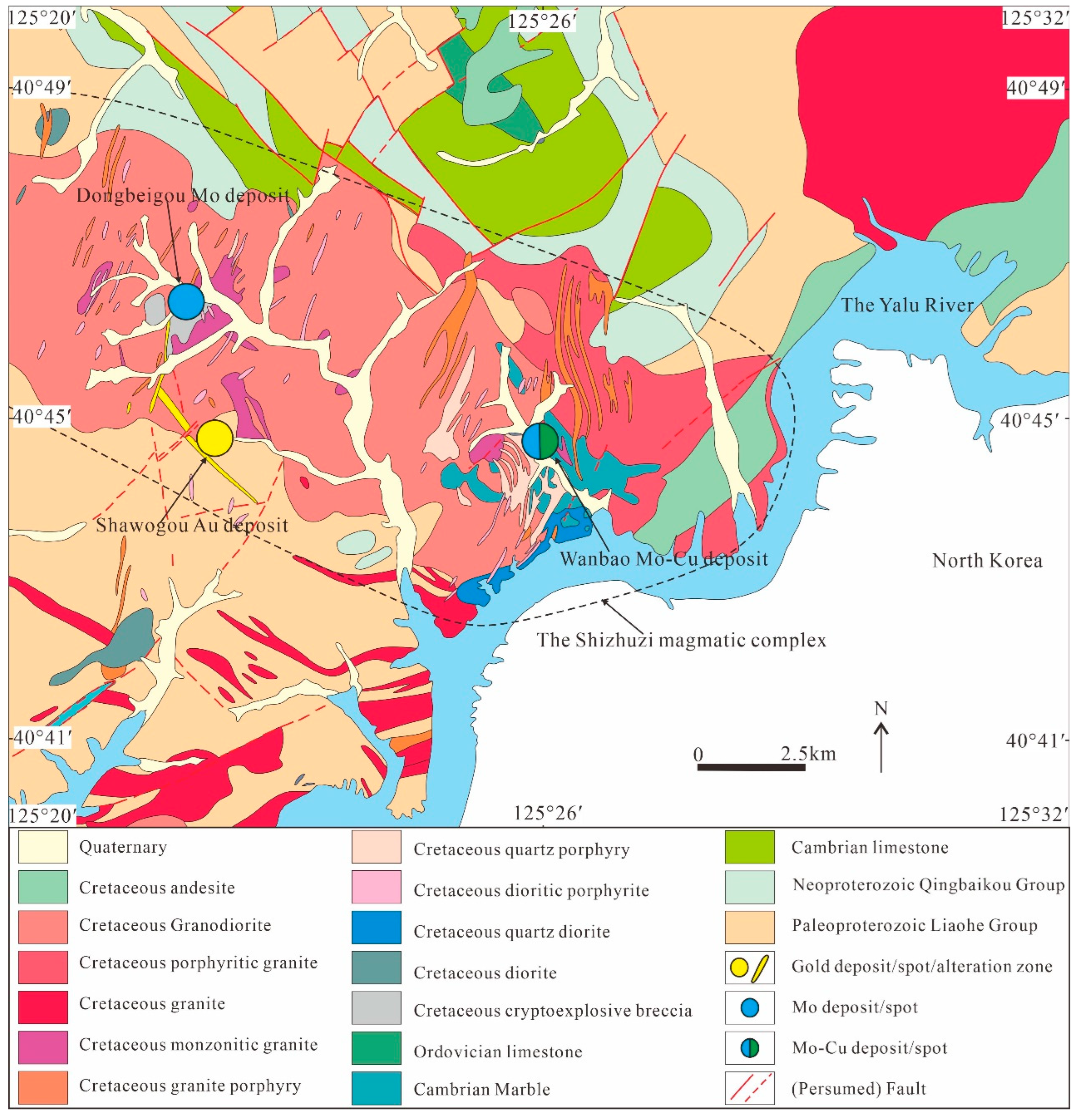
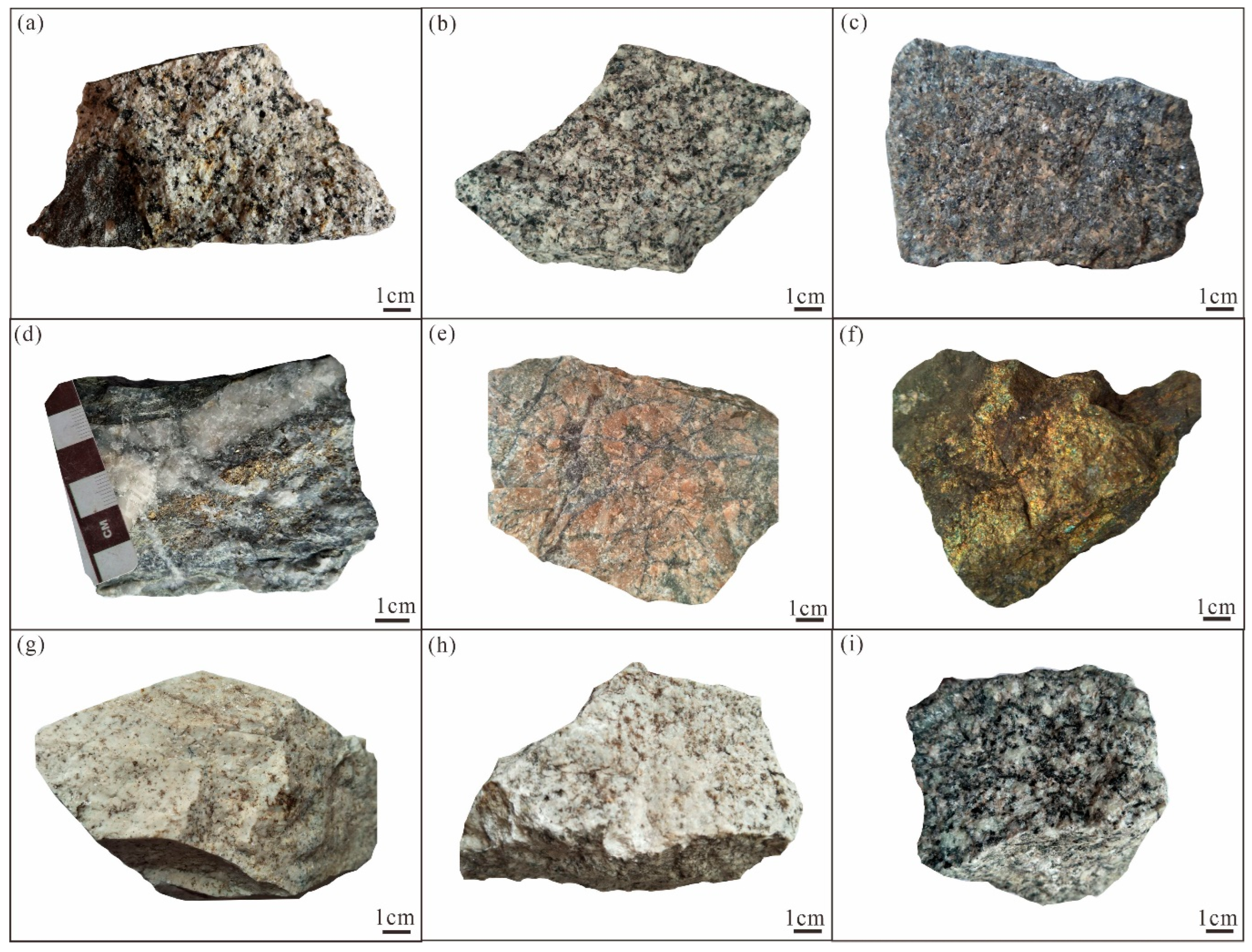

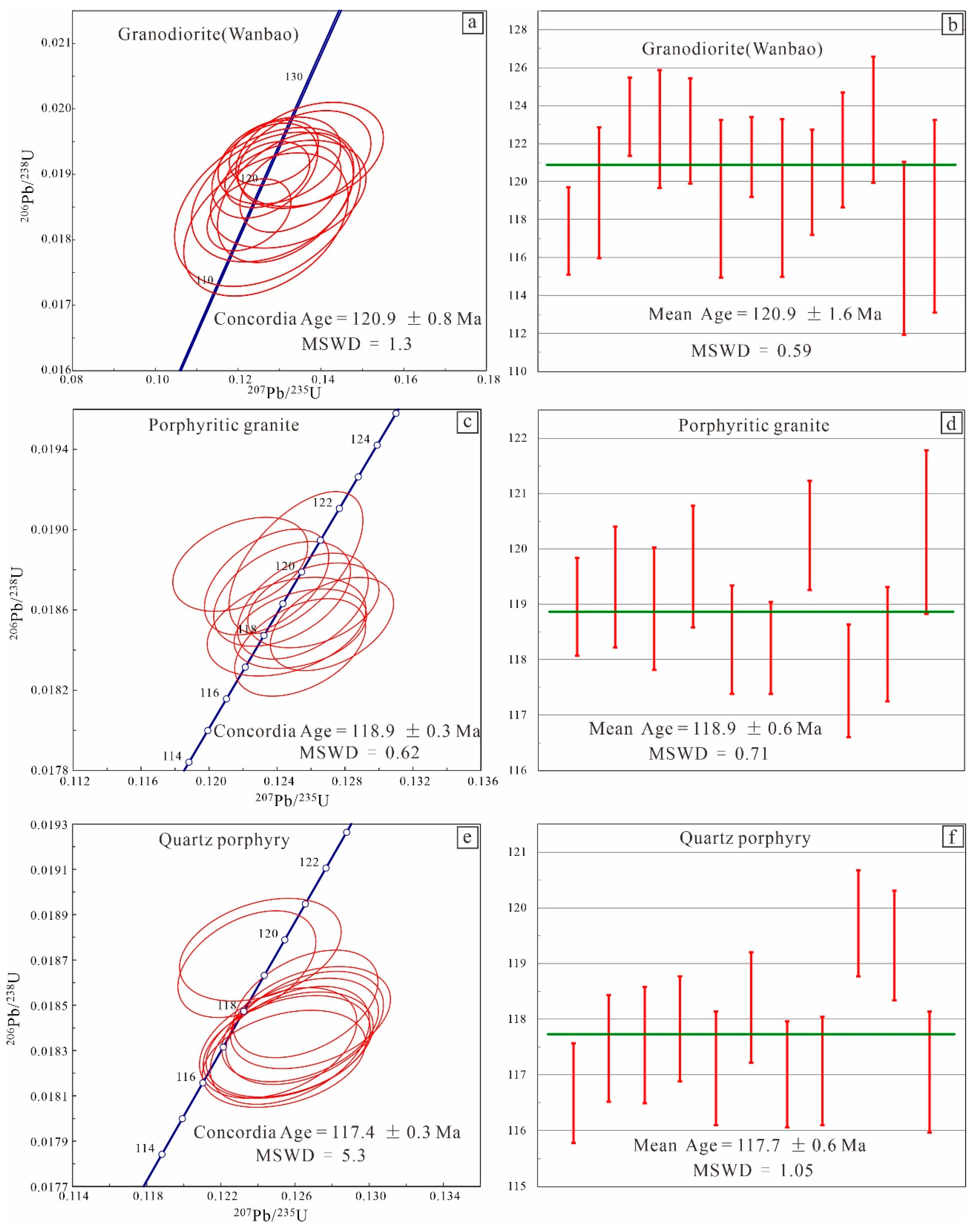
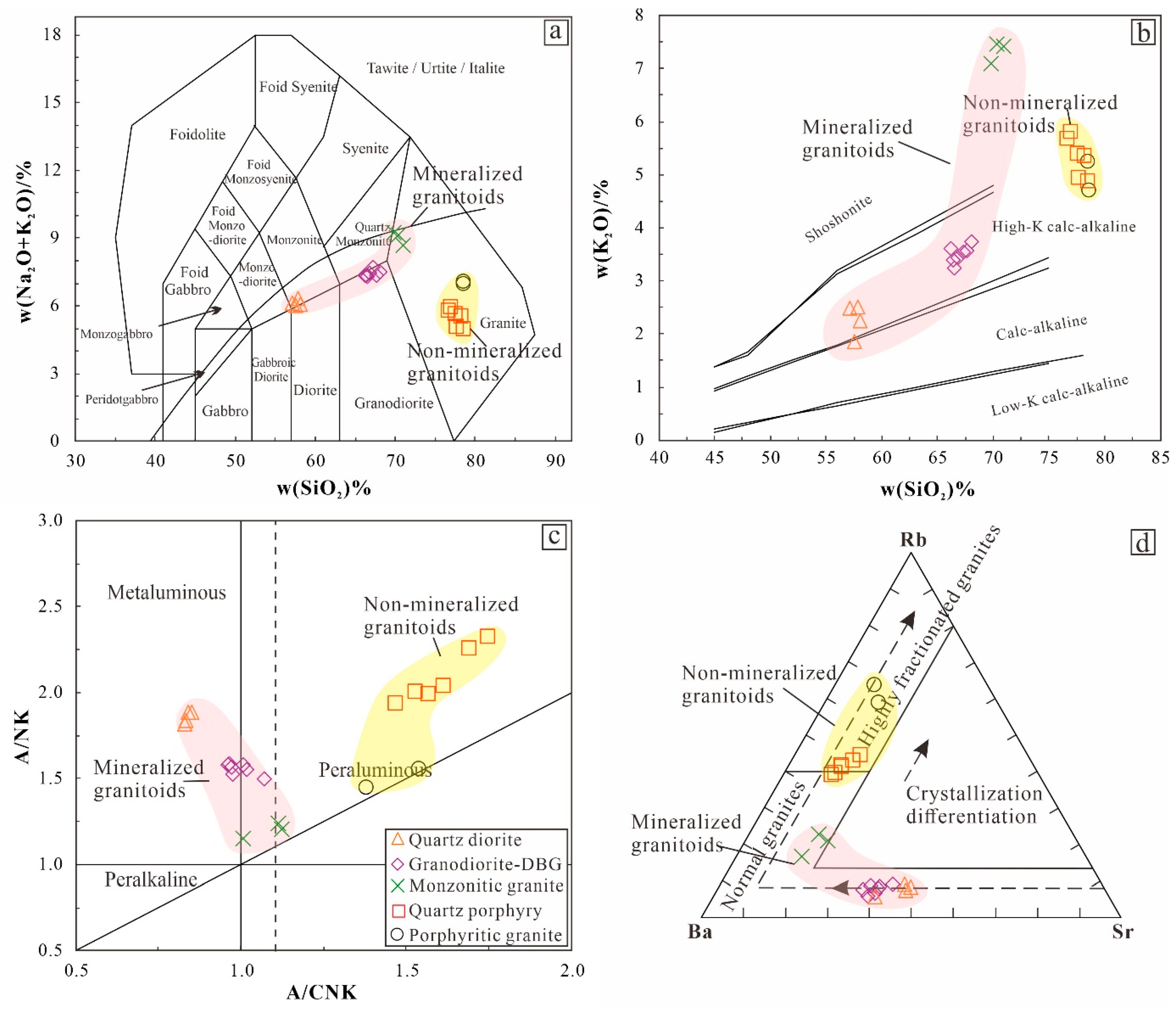
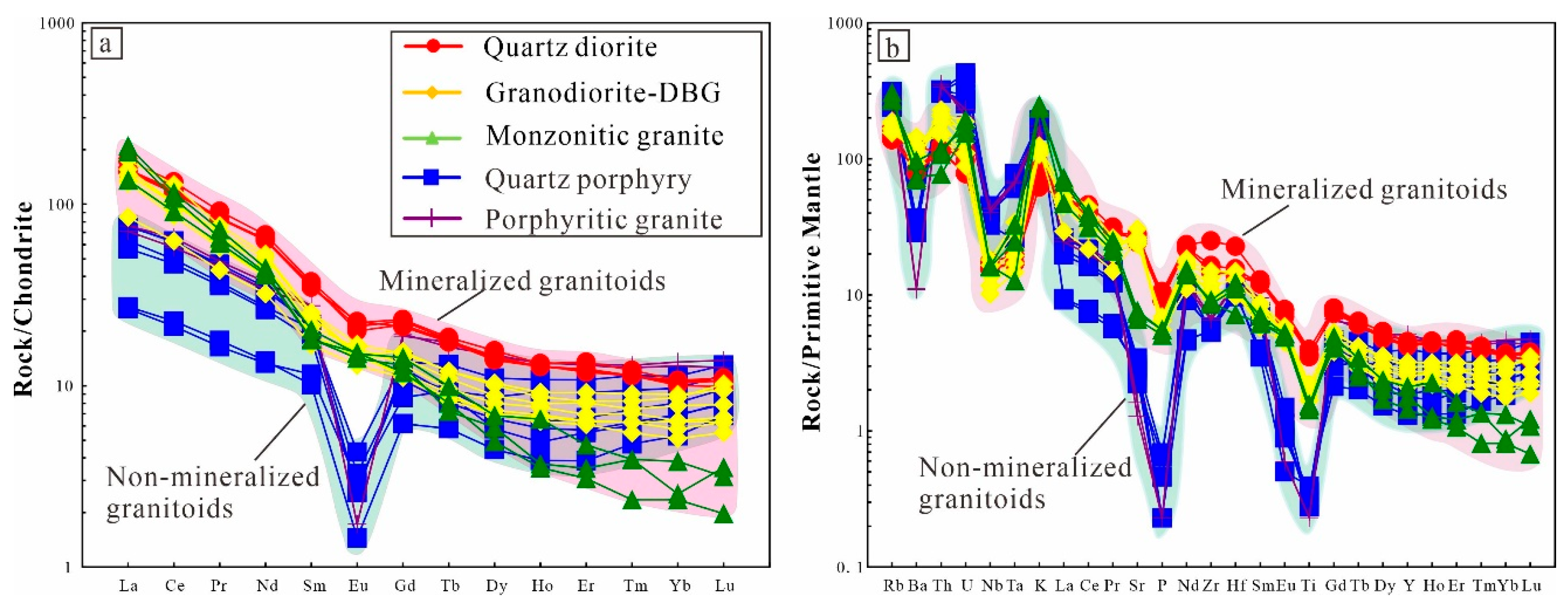
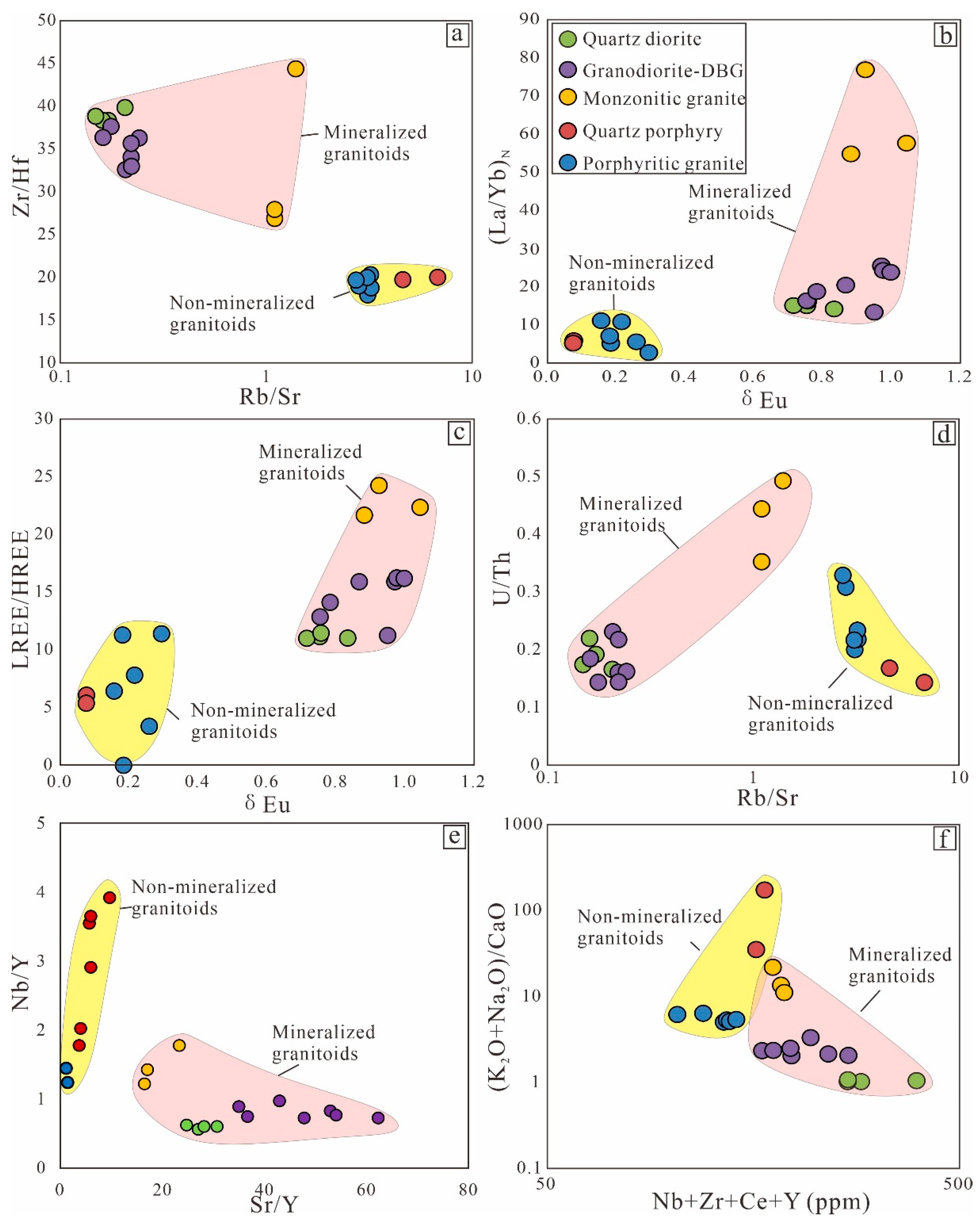
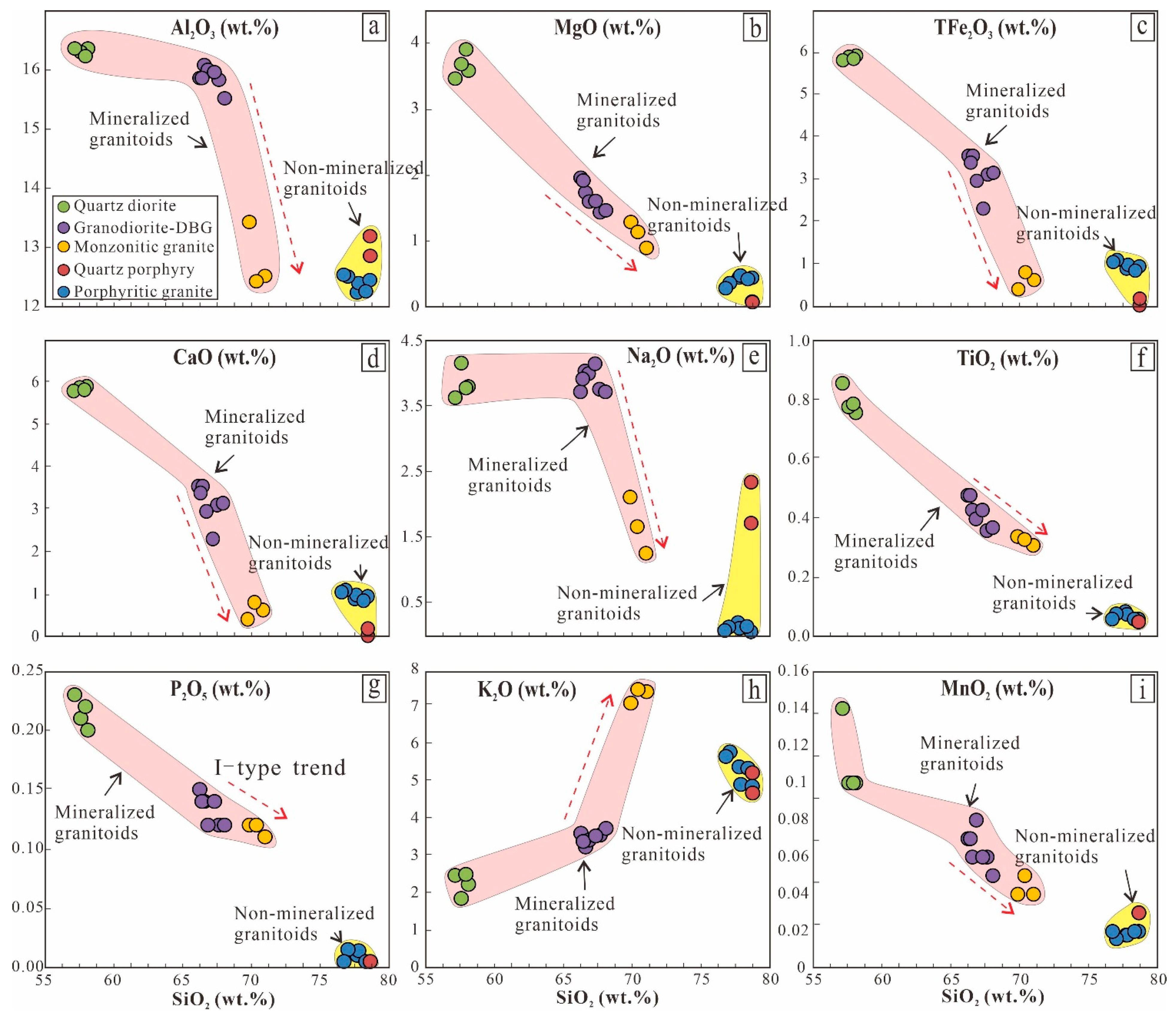



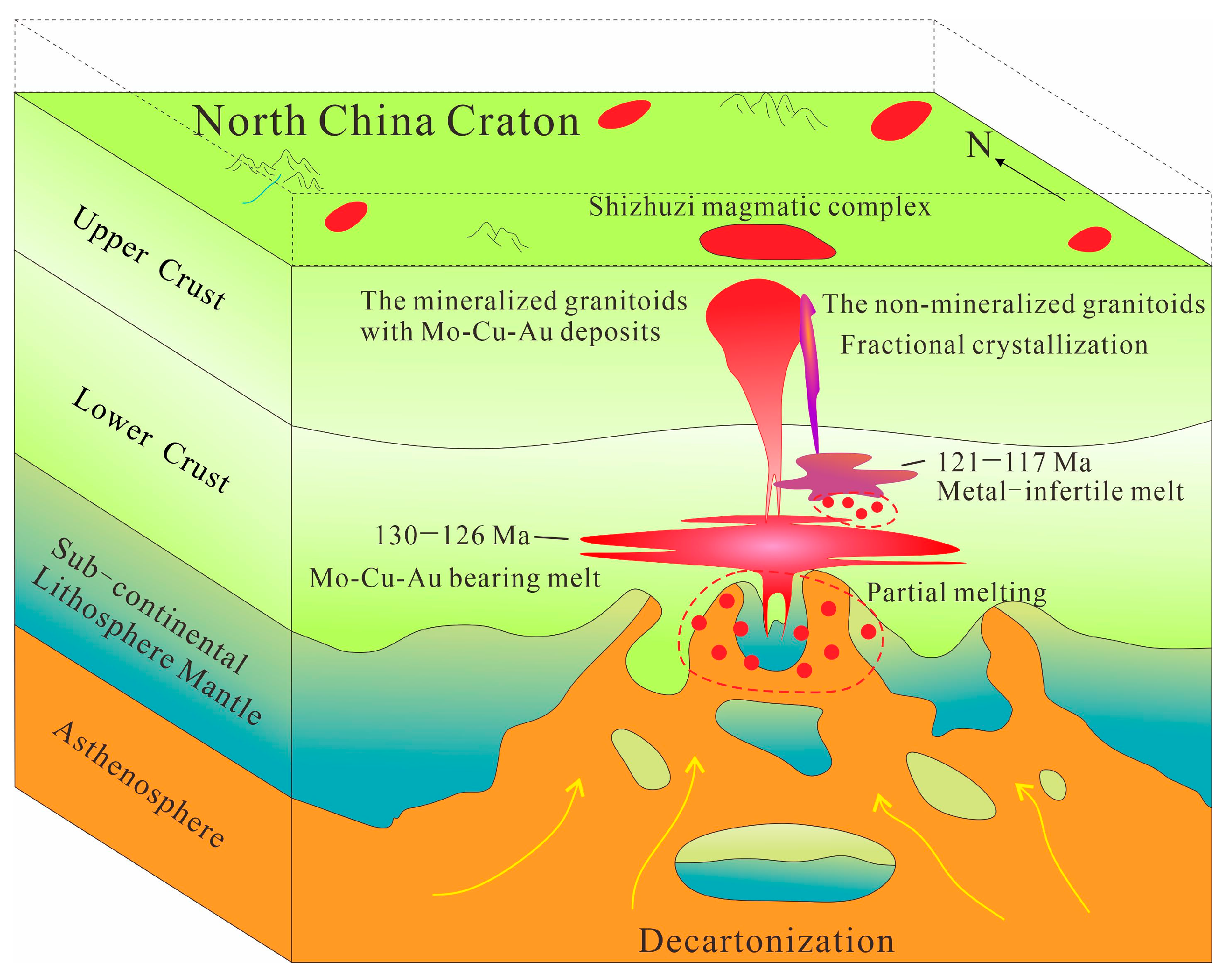
| Dongbeigou Mo Deposit | Shawogou Au Deposit | Wanbao Cu-Mo Deposit | |
|---|---|---|---|
| Position in the SMC | Central to northwestern | Southwestern | Eastern |
| Mineralization type | Stockwork-disseminated type, Quartz-vein type, Cryptobreccia type | Quartz-vein type | Skarn type, Quartz-vein type |
| Associated granitoids and country rock | Granodiorite, Monzonitic granite, Cryptoexplosive breccia | Granodiorite, Porphyritic diorite, Gaixian Formation | Granodiorite, Quartz diorite, Skarn, Marble |
| Alteration | Potassic, Propylitic alteration, Sericitization, Carbonatization | Silicification, Pyritic sericitization, Chloritization, Carbonatization | Skarnization, Sericitization |
| Scale | >100 kt Mo/0.11% | >3 t Au/3.12–6.20 g/t | >35 kt Mo/0.095%; >996 t Cu/0.72% |
Disclaimer/Publisher’s Note: The statements, opinions and data contained in all publications are solely those of the individual author(s) and contributor(s) and not of MDPI and/or the editor(s). MDPI and/or the editor(s) disclaim responsibility for any injury to people or property resulting from any ideas, methods, instructions or products referred to in the content. |
© 2025 by the authors. Licensee MDPI, Basel, Switzerland. This article is an open access article distributed under the terms and conditions of the Creative Commons Attribution (CC BY) license (https://creativecommons.org/licenses/by/4.0/).
Share and Cite
Wu, J.; Yang, J.; Yang, J.; Zeng, Q. Contrasts in Two-Stage Superimposed Magmatism of the Shizhuzi Magmatic Complex-Mo-Cu-Au System, Liaodong Peninsula, North China Craton. Minerals 2025, 15, 631. https://doi.org/10.3390/min15060631
Wu J, Yang J, Yang J, Zeng Q. Contrasts in Two-Stage Superimposed Magmatism of the Shizhuzi Magmatic Complex-Mo-Cu-Au System, Liaodong Peninsula, North China Craton. Minerals. 2025; 15(6):631. https://doi.org/10.3390/min15060631
Chicago/Turabian StyleWu, Jinjian, Jinzhong Yang, Jinhui Yang, and Qingdong Zeng. 2025. "Contrasts in Two-Stage Superimposed Magmatism of the Shizhuzi Magmatic Complex-Mo-Cu-Au System, Liaodong Peninsula, North China Craton" Minerals 15, no. 6: 631. https://doi.org/10.3390/min15060631
APA StyleWu, J., Yang, J., Yang, J., & Zeng, Q. (2025). Contrasts in Two-Stage Superimposed Magmatism of the Shizhuzi Magmatic Complex-Mo-Cu-Au System, Liaodong Peninsula, North China Craton. Minerals, 15(6), 631. https://doi.org/10.3390/min15060631






